IPADS PhD student conducting sustainable agricultural development research, investigating craft chocolate and specialty cacao
“Craft chocolate and specialty cacao has the potential to push the industry in a more sustainable direction; better farming practices to support biodiversity and conservation, ethical sourcing to improve farmer livelihoods and bargaining power, and higher quality overall, including flavor and diversity.”
Jeana Cadby is an IPADS PhD student, researching craft chocolate and specialty cacao under the supervision of Professor Tetsuya ARAKI in the International Agro Informatics Laboratory. After earning a master’s degree in Tropical Plant and Soil Sciences at the University of Hawaii at Manoa, her research career at the University of Tokyo has taken her around the world to work with cacao producers, researchers, and industry members.
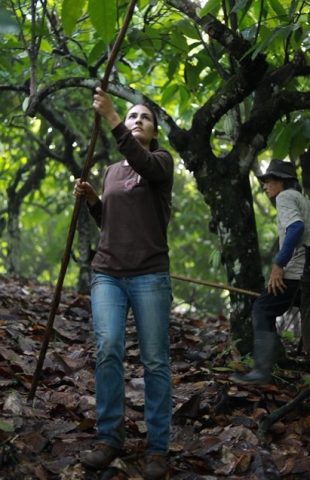
< Jeana, harvesting cacao pods on a farm in Costa Rica where she conducted some of her research. Photo credit: D.C. O’Doherty>
As a lifelong fruit enthusiast, Jeana’s journey to sustainable agricultural development in cacao production started when she was an undergraduate student at the University of Hawaii, researching in the Beverage Crops Lab, which specialized in coffee, cacao, and kava. After having her first taste of the delicious fruit pulp that surrounds the cacao seeds, she became interested in the process of cacao seeds becoming chocolate. Since then, she has conducted her fieldwork in six countries across the globe; Philippines, Vietnam, Ecuador, Costa Rica, Hawaii, and with craft chocolate makers in Japan, her present base and one of the major cacao bean importers.
“Chocolate is a global product, consumed all over the world, and Japan is a major player in terms of consumption and industry development,” she said.
Cacao is a fruit, produced mostly in tropical growing regions, primarily by small-holder farmers. The seeds of the cacao tree (Theobroma cacao) are the primary ingredient used for making chocolate. There are many steps that go into the production process before it even reaches the chocolate makers hands. Pods are harvested from cultivated trees, and the juicy pulp surrounding the seeds undergoes a multi-day fermentation process, followed by a drying process, before the beans can be packaged for transit.
Her research investigates the current state of the industry, and seeks to demonstrate the potential for specialty cacao in the production of sustainable chocolate, promoting diverse agroforestry systems, and higher shares of revenue for farmers. Her expertise in conservation and sustainable agriculture was a big inspiration for her decision to leverage science-based research initiatives to address real world applications in the chocolate industry. She is excited about the potential of specialty cacao and craft chocolate in shaping the way that the industry moves forward.

<Fresh cacao pods. PC: J. Cadby>
Jeana is now finishing up her PhD research work in craft chocolate and specialty cacao, and is partnering with various research organizations that work to address climate change issues, sustainable development, and promote diverse agroforestry programs. Her next project will take her to the Brazilian Amazon, where she will work with indigenous farmers producing cacao from wild cacao trees, under mixed agroforestry conditions, to further develop their production systems.
CHALLENGES OF MODERN CACAO PRODUCTION
Through her research and fieldwork, she highlighted that some of the challenges of modern cacao production include the loss of forest lands and biodiversity habitats, especially due to agricultural expansion for high-yielding cacao varieties grown in full sun, monoculture conditions, with high fertilizer and pesticide requirements. In addition, the profit share for farmers is often marginal, unpredictable, and volatile, making the sustainable development for cacao producing regions more difficult. She states, “cacao farmers often live under the poverty line, and experience extreme price volatility and seasonal fluctuations, while using production methods that are detrimental to local forestlands and threaten biodiversity conservation.”
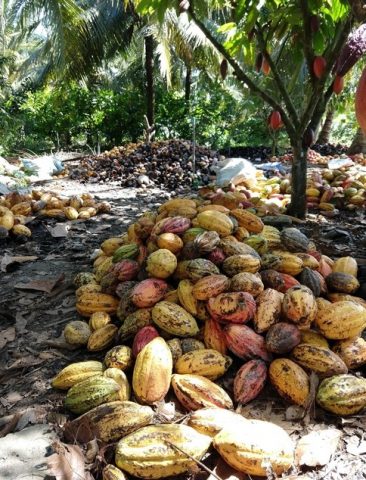
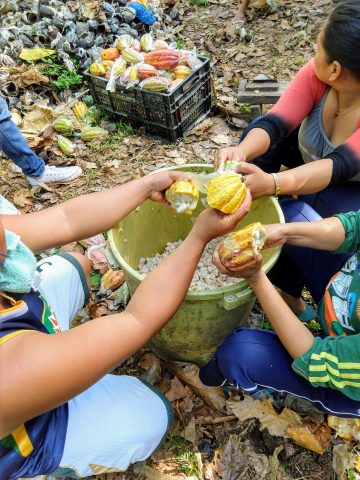
<Fresh cacao seeds are manually removed from their pods on the farm before being sold by fresh weight to a fermentation facility in Biao, Philippines. PC: J. Cadby>
Another issue she mentions is that the majority of cacao beans used for chocolate production are sold on the commodity market, where buyers hold significantly more negotiating power, and typically do not work directly with farmers. “With commodity-bound, or industrial cacao, the value chain is often long and disjointed, and these high-yielding monoculture systems are an attractive option for short term economic gain but not for sustainable agricultural development in cacao production,” she said.
RESEARCH ON CRAFT CHOCOLATE AND SPECIALTY CACAO
Jeana said that craft chocolate and specialty cacao potentially offers an alternative to that system. She explains, “cacao produced for the specialty market is typically directly traded between the craft chocolate maker and the farmer or producer. Specialty cacao that is directly traded allows farmers to potentially benefit from price premiums offered for higher quality beans. Although this industry still holds a fairly small portion of the total market, there is potential to highlight opportunities and instill changes to the industry as a whole.”
Craft chocolate (or “Bean to bar” chocolate) is an artisan product which highlights the unique nuances of the fine-flavor or specialty cacao beans from which it is made.
“We are even starting to see better recognition of specialty cacao varieties, such as Nacional, produced in Ecuador. Consumers seem excited to educate themselves about chocolate,” she said.

assets.s3.amazonaws.com/uploads/2018/08/What-We-Do-Subs-Box-Aub-18.jpg
The “bean to bar” movement has been growing in momentum in recent years, allowing craft chocolate makers fill the market niche for consumers looking for a higher quality product with an emphasis on high flavor notes and ethical sourcing.
“Many craft chocolate makers prioritize product quality, farmer welfare, and better consciousness for impacts on the environment, stemming from sustainability and social responsibility challenges witnessed in the production of industrial chocolate, as well as aligning with the values of many modern consumers. This growing industry has recently seen exponential growth, and offers a good opportunity to address timely issues in the chocolate industry as a whole. Bean to bar chocolate and single-origin chocolate can be traced back to the farm producing the cacao beans, using sourcing methods which provide opportunities for increased quality and traceability.”
However, she witnessed through her research work with craft chocolate makers in Japan that craft chocolate makers, mostly small-scale producers often assess cacao quality based on internal quality standards. Therefore she explained that developing more robust quality assessment protocols is necessary, that are more widely accessible to rural farmers, yet comprehensive enough to meet the needs of quality-focused chocolate makers. Giving farmers access to resources which allow them to communicate the value of their product and gain more bargaining power, using a shared language, can help build an industry with higher standards for quality and producer profit share.

< Cacao beans are turned by workers to incorporate oxygen during the aerobic fermentation process in Davao, the Philippines, where Jeana conducted some of her fieldwork. PC: J. Cadby>

<A cacao bean cut during a fermentation in Ecuador. Acetic acid producing bacteria oxidizes ethanol and various acids, releasing sweltering heat and breaking down cell walls, helping to develop characteristic cocoa flavor. PC: J. Cadby>
“The craft chocolate and specialty cacao industry still struggles to clearly define industry standards and communicate quantifiable quality.” she stated. To address these issues, Jeana’s research investigates the current needs and priorities of craft chocolate makers and specialty cacao producers. “The industry could benefit from the development of consistent price premiums and clear industry standards, to encourage farmers to adopt sustainable production of specialty cacao, and support chocolate makers in meeting quality needs. Improved coherency of quality quantifiers and standardization for this industry would allow farmers to better communicate with buyers. “
Her main focus is on the sustainable development of cacao producing regions. “In terms of sustainable development, I am working on identifying the current gaps for the specialty cacao industry to facilitate a shared language with which producers and buyers can communicate. Having a clearer definition of the industry can also help to differentiate craft and specialty products from their commodity counterparts, and further establish the viability for the future of chocolate.”
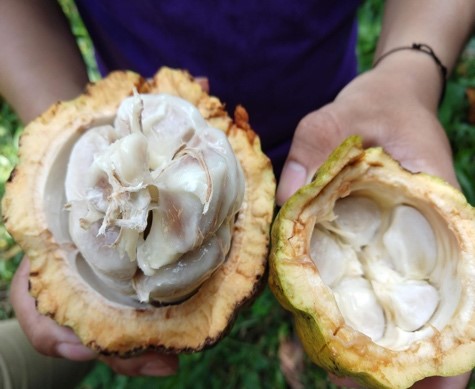
<A fresh cacao pod in Vietnam. Cacao seeds are neatly arranged within the thick rind of a cacao pod, surrounded by sweet pulp. The pulp surrounding the seeds is what undergoes fermentation, aided by microbes in a tandem anaerobic and aerobic fermentation process. PC: J. Cadby>
REFLECTIONS FROM ABROAD
With research projects spanning around the world, her research and partnerships have shown her what a small world it is we live in. “When you don’t know who your farmer is, the problems in the middle of the supply chain are not your problem. I have been fortunate enough to be able to connect with industry members, and learn about what it takes to make a living as a farmer in the far corners of the earth, while committing to long-term strategies for growth. Craft chocolate and specialty cacao can potentially move the industry to improve. We already see commodity cacao and industrial chocolate companies pledging to transition towards sustainably and ethically sourced cacao as a result of consumer demands.”
Her research work in the Philippines is focused on investigating simple, cost effective measures to dramatically improve cacao quality. She spent three months in the Davao region of Mindanao Island, working with farmers and cooperatives on improving post harvest production practices. “Taking pride in your work is an international concept. Many farmers are excited to be a part of a bigger movement to create real change in this industry, and of course be responsible stewards for our planet.”
Jeana believes that the future of chocolate is bright. “Here is a crop with so much potential, we are only beginning to scratch the surface of what secrets are hidden within. It is amazing to see so many farmers, chocolate makers, and chocolate eaters, all over the world, so passionate about this crop. With our shared passion, we have an opportunity to take something really special, and use our collective knowledge as a tool to raise each other up and support a better future for people, for sustainability, and for our planet.”
WORDS FOR NEWCOMERS
“IPADS is such a diverse program, there is a lot of opportunity to follow your interests while working in an interdisciplinary setting. For my research, connecting with international research institutions proved to be beneficial in meeting shared goals and gaining better access to resources. I greatly appreciate the industry members who have volunteered their time, it really speaks to the power of community. Also, I am so grateful for my current advisor for his wonderful support and in helping me to reach my research objectives. This network has been a great asset to me, and I really appreciate everyone who has helped me throughout my research. My advice is to use these resources effectively.”
FUTURE PLANS
“I’m interested to see how this industry develops, including what we can learn and apply from other similar industries with shared values. I’m excited to continue my work in sustainable development, finding ways to be better stewards for our planet by identifying low hanging fruit and implementing organizational needs. I also hope that this research can help to empower those who have the resources to support sustainable practices and ethical systematic change to take positive action.”
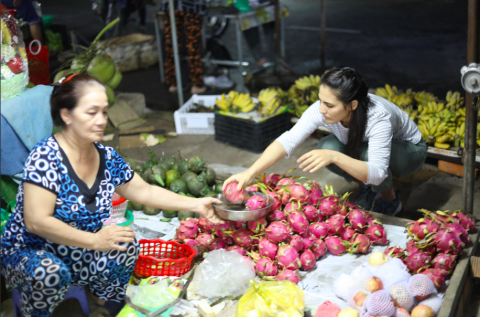
<Jeana, selecting fruits at a market in Vietnam. Her enthusiasm for researching sustainable development stems from building shared connections and a love of fruit. PC: D.C. O’Doherty>
<PROFILE>
Name: Jeana Cadby
Country of origin: U.S.A.
Laboratory: International Agro Informatics Laboratory, International Program in Agricultural Development Studies (IPADS)
Favorite pastime in Tokyo: Exploring the city! Japan has such a beautiful and diverse landscape with so much to offer, every day is an adventure!
<Interviewed by Noriko FUJIMOTO, IPADS Office>